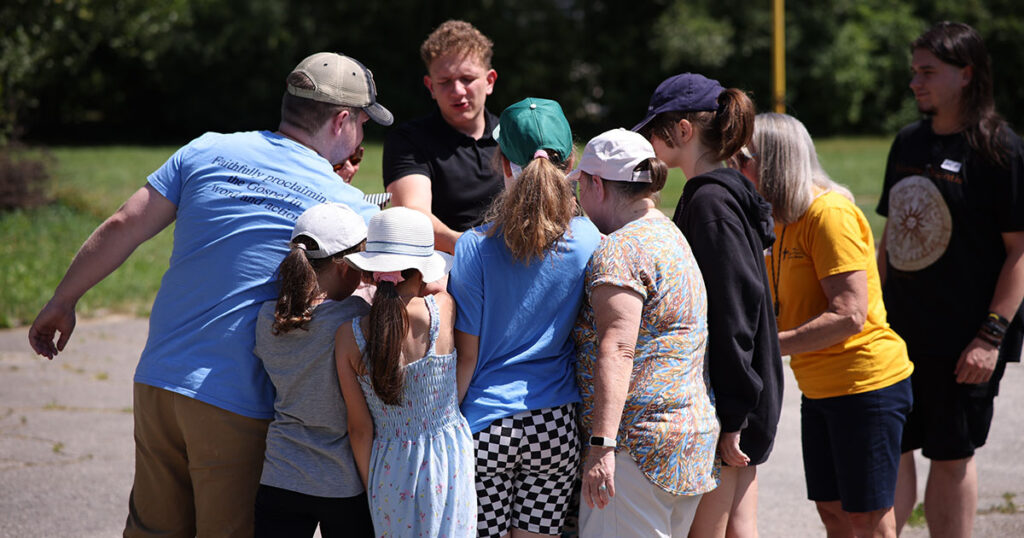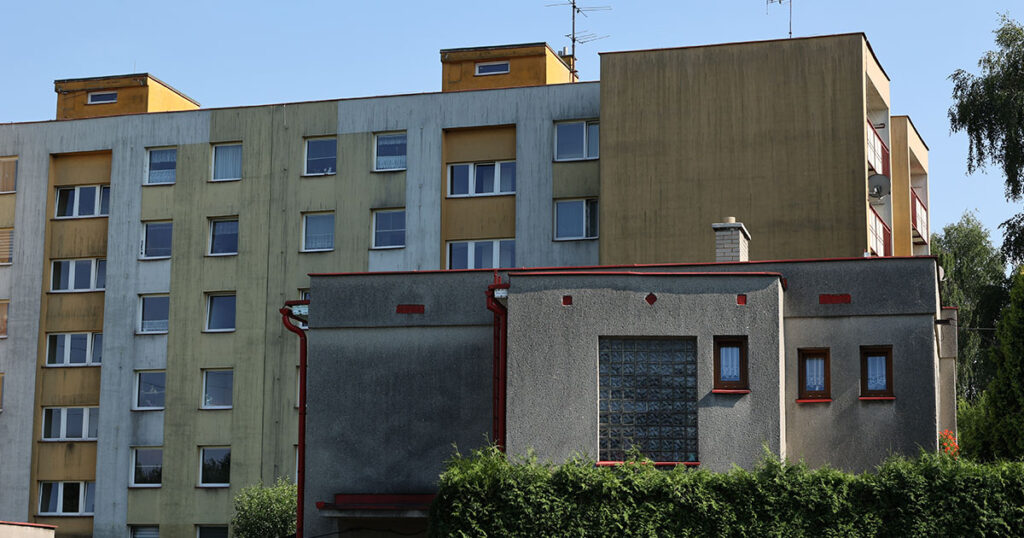
Local Christian young adults work with children during an LCMS International Mission English Bible Camp in the Czech Republic in July 2023. (Photo courtesy of Mark Winterstein.)
Story 6 of 6 — Spring 2024
The Lutheran Church—Missouri Synod’s Office of International Mission has compiled a series of six commentaries about the experiences of short-term mission volunteers who served during an English Bible Camp in the Czech Republic in July 2023. The sixth commentary is below, and all of the stories are available in the series archives.
Crystal Potts, LCMS Short-term Mission Volunteer
In the last week, I’ve seen many faces of the Czech Republic. In rugged, remote forest churches, in picture-perfect storybook village churches, and in museum-quality UNESCO-protected churches.With exposure to each new setting comes a more complete picture of the country as a whole.
Today, in the neighborhood of Sumbark in the city of Havířov, Czech Republic, I sit in a small, square room in a large, square building with about 20 locals who are more than willing to endure this tightly packed space on a swelteringly hot Havířov afternoon (sans air-conditioning because, let’s face it, these folks are just plain tough) in exchange for an evening of worship.
This is the Czech Republic that many imagine when Central or Eastern Europe enters into conversation or thought. The service here is a combination of message (delivered in Czech but with an interpreter on hand to translate into English) and music (presented via a keyboard, a guitar, and three talented voices). It is simple yet beautiful in its simplicity.
Another small part of the space in use by the church is designated as a kitchenette/coffee bar as this group likes to share a meal and an evening espresso following worship, and the remaining fraction of the space is allotted as a children’s room. It is efficient in a way that can be seen as synonymous with some misconceptions of eastern Europe.
As Americans, we are wary of the parts of Eastern Europe that we don’t fully identify with or understand (ahem, Russia). For the citizens of Poland and the Czech Republic, however, the attitude toward our Russian friends is, interestingly, quite complicated.

This nondescript building is an example of Soviet-era architecture in the Czech Republic. (Photo courtesy of Mark Winterstein.)
Quick history/architecture lesson
Havířov is a city in the Karviná District in the Moravian-Silesian Region of the Czech Republic. It has about 70,000 inhabitants, making it the second-largest city in the region.
Havířov was founded in 1955 and is the youngest Czech city. Havířov was founded on top of several villages with significant Polish populations after World War II to restore the industry of hard coal mining in the region. Construction of the first housing estates for miners and their families began in 1947. Most of the buildings here were built in the style of socialist realism.
Let’s pause there and dig in a bit. Socialist realism is a style of idealized realistic art that was developed in the Soviet Union and was the official style here between 1932 and 1988, as well as in other socialist countries after World War II. Socialist realism is characterized by the depiction of communist values and is usually devoid of complex artistic meaning or interpretation.
In countries occupied by the USSR, such as the former Czechoslovak Republic from 1948 until the fall of communism in 1989, socialist realism was manifested to convey an extremely literal and obvious meaning, usually showing an idealized USSR.
Socialist realism is fascinating, and I encourage you to read more about it if you have time. One category of this style is likely more familiar than you might realize. We’ve all heard a mention or description at some point in books, films or from those who have visited the region of the infamous Communist Bloc.
The bloc style of architecture common to parts of Russia and Eastern Europe (also known as brutalism) is often considered harsh, cold and sometimes even depressing. Rarely, if ever, is it considered beautiful. To its designers and proponents, however, it did represent a kind of beauty.
A significant portion of the older generations of Czechs maintain a level of nostalgia for the Communist era. They will tell you that during that time, things were simple, jobs were plentiful, and the government was consistent. Efficiency. Equality. Simplicity. Uniformity. Idealism.
When viewed individually, these characteristics are all theoretically positive characteristics. Put them together, though, and things begin to sound a bit too much like one of the unforgiving, extremist political regimes that we often view in direct contradiction with common American ideals like freedom and capitalism.
But what if the truth is somewhere in the middle? What if, like the spare, utilitarian design of this church plant in Havrivov, the truth is more deeply embedded in the intent of an ideal rather than its aesthetic implication? Could these bloc buildings be seen as beautiful, then?
The espresso bar portion of this space is staffed almost entirely by youth volunteers/members of the church who choose to spend their evenings here serving at church services and participating in English talk groups or game nights whenever possible. They all speak excellent English and tell me excitedly about their future plans to attend university or theological college or just about how excited they are to help with the upcoming English Bible Camps and share the love of Jesus.
Most of these remarkable young people came to this church plant initially to participate in the English talk groups or various youth groups offered weekly. Havířov doesn’t have a lot to offer in terms of activities for teens and young adults, but then they discovered that their knowledge of Christianity and specifically of Lutheranism might not be complete.
Over time, many of them joined the church and converted to Lutheranism partly because of the beauty of God’s love and the grace that is at the core of the faith. These young people see the world through a lens of possibility due, at least in part, to the impact of this church in their lives.
It is an impact that they so value that they voluntarily serve at the English Bible Camp to further the reach and impact of the church on the community. It has been said that there is beauty in simplicity. I think that nowhere, perhaps, is that sentiment more perfectly proven true than in this strikingly simple, utterly beautiful little church plant in the Havířov.
This is, indeed, the Czech Republic.
To serve alongside similar churches and missionaries, visit servenow.lcms.org to find your opportunity to serve.